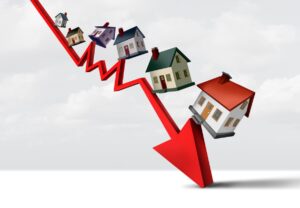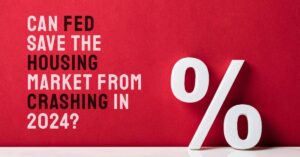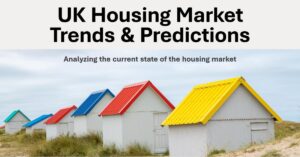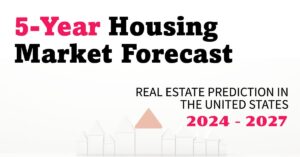As of the latest available data, the Canadian housing market remains balanced, with a sales-to-new listings ratio within the range indicative of equilibrium. While slight fluctuations in inventory and sales activity are expected in the coming months, the overall outlook suggests a market that offers opportunities for both buyers and sellers.
The Current State of the Canadian Housing Market
The Canadian housing market has recently experienced a significant shift, marking an end to a period of decline and ushering in a sense of anticipation as the spring market approaches. According to the latest data from the Canadian Real Estate Association (CREA), home prices, as measured by the Aggregate Composite MLS® Home Price Index (HPI), remained unchanged on a month-over-month basis in February 2024. This stabilization follows five consecutive declines since the fall of the previous year.
How is the Canadian Housing Market Doing?
February's flat prices contrast with the 1.3% drop observed from December to January, indicating a sudden change in direction. Such abrupt shifts are rare in the typically stable realm of housing price adjustments. In fact, over the last two decades, there have only been three other instances where a month-over-month percentage change of this magnitude occurred, all coinciding with periods of heightened demand.
Shaun Cathcart, Senior Economist at CREA, notes that February may signal a turning point in the 2024 housing narrative. He suggests that the focus will likely shift from the timing of interest rate cuts to the number of homes hitting the market this year, considering the pent-up demand waiting to be fulfilled.
How Competitive is the Canada's Housing Market?
Despite the recent stabilization in prices, national home sales dipped by 3.1% month-over-month in February. However, actual activity, not seasonally adjusted, surged by 19.7% compared to February 2023. This increase in activity reflects both the rebound from historically low sales figures in February 2023 and the current market's resilience, which has climbed back to near the 10-year average.
With the anticipation of increased housing activity, Larry Cerqua, Chair of CREA, suggests that buyers may be waiting for cues from the Bank of Canada or for the spring listings to hit the market. The slight decrease in the national sales-to-new listings ratio, alongside a rise in new listings, hints at a market that is poised for growth but remains balanced.
Are There Enough Homes for Sale to Meet Buyer Demand?
Despite the uptick in new listings, there were 3.8 months of inventory nationally at the end of February 2024, slightly up from January's 3.7 months. While this increase indicates a slight easing of inventory constraints, the long-term average sits at around five months, suggesting continued tightness in supply.
The number of newly listed homes edged up by 1.6% month-over-month in February, with expectations of further increases in the coming months as owners prepare to list their properties for sale in the spring market.
What is the Future Market Outlook for Canada?
Looking ahead, the Canadian housing market is poised for increased activity, driven by pent-up demand and the approaching spring season. While February marked a relatively stable period, the coming months are expected to see heightened buying and selling activity.
The actual national average home price in February 2024 stood at $685,809, reflecting a 3.5% increase compared to the same month in the previous year. This steady appreciation underscores the resilience of the Canadian housing market despite recent fluctuations.
ALSO READ: US Housing Market Predictions
Canada Housing Market Predictions: Will it Crash?
The Canadian housing market in January 2024 showed resilience and continued growth, with steady increases in both home prices and sales figures. While certain provinces may experience fluctuations, the overall outlook remains optimistic.
Canada Home Prices
In January 2024, the average home price in Canada stood at $659,395, reflecting a modest 0.3% increase from the previous month and a significant 7.7% surge compared to the same period last year. This uptrend in prices underscores the robust demand for residential properties across the country.
Canada Home Sales
The Canadian housing market experienced strong sales activity during January 2024, with 39,399 homes sold nationally. This represents a noteworthy 18% increase year-over-year and a 4% uptick from the previous month, indicating a healthy level of market activity.
Benchmark Prices Across Provinces
Examining benchmark home prices across Canadian provinces reveals varying trends. While some provinces, like Alberta and Saskatchewan, witnessed incremental growth in benchmark prices, others experienced contractions. British Columbia maintained its position at the forefront, boasting a benchmark price of $952,100, while New Brunswick recorded the lowest benchmark price at $283,700.
Sales-to-New-Listings Ratio (SNLR)
A crucial metric for assessing market equilibrium, the Sales-to-New-Listings Ratio (SNLR) for January 2024 stood at 58.8% nationally, indicating a balanced market. This equilibrium suggests that both buyers and sellers are operating within a fairly stable environment, with ample opportunities for transactions.
Market Dynamics
Despite the prevailing sellers' market conditions observed across many provinces, particularly during the year-end period, characterized by limited inventory and heightened demand, the overall sentiment remains positive. Sellers are receiving reasonable offers, while buyers have the flexibility to explore various options.
Regional Canadian Housing Market Outlook
Ontario
Ontario's housing market experienced a slight downturn in January 2024, with the average home price decreasing by 3.8% compared to December 2023. Despite this dip, home prices in Ontario remain elevated, second only to British Columbia. The Greater Toronto Area (GTA), a focal point of Ontario's real estate landscape, witnessed mixed trends.
While the average home sold price in the GTA decreased by 1.2% year-over-year to $1,026,703, home sales surged by 36%, with 4,223 transactions recorded in January. Mississauga stood out with a remarkable 10% increase in home prices, reaching $1,048,658, while neighbouring Brampton experienced a slight decline. Other regions like Hamilton, Ottawa, Kitchener-Waterloo, and Oshawa displayed varying patterns in home prices, reflecting the diversity of Ontario's real estate market.
British Columbia
British Columbia maintained its position as the province with the highest average home price in January 2024, despite a slight decline of 0.8% from the previous month. With an average home price of $957,909, British Columbia's real estate market remains robust and attractive to buyers.
Greater Vancouver, in particular, stands out as the most expensive city in Canada to purchase a home, with an average price of $1,251,923 in January 2024. Despite some fluctuations, British Columbia saw a notable year-over-year increase of 10.5% in home prices, reaffirming its dominance in the Canadian housing market.
Quebec
Quebec's housing market witnessed positive growth in average home prices, with a 9.3% increase year-on-year, reaching $455,547. However, compared to December 2023, home prices in Quebec experienced a modest decline of 2.6%. Montreal, Quebec's largest city, saw a 7.8% annual increase in home prices, although there was a 2.8% decrease from the previous month, with the average price standing at $570,220 for January 2024.
Atlantic Canada
Atlantic Canada is experiencing notable shifts in home prices compared to the previous year. Nova Scotia, in particular, saw an impressive 13% increase year-on-year, with the average home price reaching $428,539. Similarly, Prince Edward Island (PEI) witnessed a 5.5% increase compared to December 2023, with the average home price now standing at $377,844. Newfoundland, with an average home price of $302,834 for January 2024, saw an 8% annual increase, despite a slight 0.8% decrease from the previous month.
The Prairies
The Prairies region of Canada presents a diverse landscape in its housing market. Alberta emerges as a standout performer, boasting a 12% annual increase and a 3.8% monthly growth, with the average house price reaching $476,066. Saskatchewan, on the other hand, experienced more modest growth, with a 2% annual rise and a slight decrease of 0.8% monthly. Within Saskatchewan, cities like Saskatoon and Regina displayed mixed results, reflecting the localized dynamics of the market. Manitoba showcased resilience with a slight annual decrease and a corresponding monthly decrease, maintaining an average price of $351,305.
Urban Housing Markets
Alberta's urban housing markets, particularly Calgary and Edmonton, demonstrate persistent growth. Calgary's home prices surged by 11% year-over-year to $569,361, while Edmonton experienced a 7.7% annual increase, with average prices reaching $398,724. Winnipeg in Manitoba also saw a 10% year-over-year increase, with the average home price reaching $376,618.
Other Real Estate Statistics
– Homeownership Rate: Stands at 66.5% as of 2021.
– Vacancy Rate: Recorded at 1.5% in 2023.
– Housing Starts: The trend indicates 244,800 units per year, with 14,878 housing starts in January 2024.
– Housing Under Construction: Currently stands at 353,361 units as of January 2024.
– Housing Completions: Recorded 187,630 units in 2023.
– Investment in Residential Construction: Totaled CAD $157.7 billion in 2023.
– Investment in Non-Residential Construction: Stood at CAD $71.4 billion in 2023.
These statistics provide valuable insights into the broader trends and dynamics shaping the Canadian housing market. As stakeholders navigate through these numbers, it's essential to remain attentive to regional variations and market indicators to make informed decisions in this ever-evolving landscape.
Canadian Real Estate Bubble
The Canadian property bubble refers to a significant surge in Canadian real estate prices observed from 2002 to the present. Numerous observers have characterized this as a real estate bubble.
Contributing Factors to the Bubble
- House prices outstripping incomes
- Low interest rates since the 2008 financial crisis
- Mortgage debt service ratio surging to shocking levels
- Canadian homebuyers not having the same ability to lock in a long-term fixed rate mortgage
- Canadian private debt as a % of GDP surpassing Japan's during the peak of its crisis in the early 1990s
- Canadian borrowers must renew their mortgages every five years
- Provinces and cities responsible for land-use planning, zoning, and permitting
- Real estate investors
- Foreign buyers
Experts warn that Canada is potentially facing one of the largest housing bubbles of all time, with predictions of a 24% decline in Canadian home prices. However, there is optimism that 2024 will bring more stability to the housing market. The declining mortgage rates are expected to contribute to mostly flat home prices throughout 2024.
More Topics For Reading:
Housing Market Forecast 2024 & 2025: Predictions for Next 5 Years
Where Are Housing Prices Falling in 2022?
Is it a Good Time to Buy a House or Should Wait Until 2024
Housing Affordability Crisis is Increasing in the United States
The Hottest Real Estate Markets of 2022
This article shouldn't be used to make real estate or financial decisions. Some of this article's information came from referenced websites. Norada Real Estate Investments provides no express or implied claims, warranties, or guarantees that the material is accurate, reliable, or current. All information should be validated using the below references. Norada Real Estate Investments does not predict the future Canadian housing market. Buying a property needs research, planning, and budgeting. Not all investments are good. Always do research and consult a real estate investment counselor.
Sources:
- https://stats.crea.ca/en-CA/
- https://wowa.ca/reports/canada-housing-market










